10 places to visit in Acadia National Park with kids
Acadia National Park protects the natural beauty of the highest rocky headlands along the Atlantic coastline of the United States. The park includes land on 20 different islands, as well as the southwest tip of the Schoodic Peninsula. The largest and most well-known part of Acadia is located on Mount Desert Island. When visiting, you'll find lakes, ponds, meadows and a mixture of coniferous and deciduous forests, in addition to mountains and cliffs that rise abruptly from the sea. The abundance of habitats leads to a variety of sea and land-dwelling animals. The park offers a little bit of everything: hiking, camping, boat trips, carriage rides, scenic drives, swimming and much, much more. Not only will you leave in awe of the beauty of Acadia, but you won’t be disappointed in the amount of family-friendly activities that the park has to offer.
After my husband was laid off at the end of August, we decided to buy a pop-up camper, throw our camping gear in the car, along with our two kids (ages 1.5 and 3.5 years) and head north, hitting several destinations, including Acadia National Park. We had a general idea of where we wanted to stop, but our “itinerary” was created as we went. If you haven’t tried traveling like this in the past, consider doing it someday. It frees you from a rigid, over-planned trip and allows you to live in the moment. That being said, we did look at a map before we left, making a list of places that we wanted to see, and we rented some travel books from the library to take with us. From our experience, here are a few tips and a list of family-friendly things to do while visiting Acadia National Park. 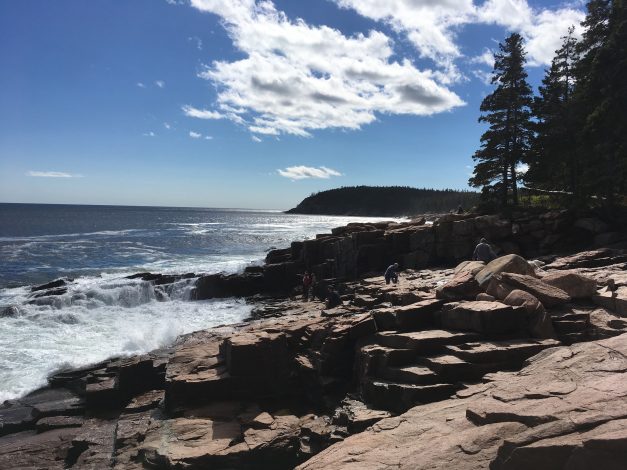
PLANNING
A few important things to consider when planning a trip to Acadia are what time of year you want to go and where you will be staying. Since our travels in Acadia were driven by the timing of the layoff, we ended up visiting at the very end of September. The whole family loved traveling at this time of year because the trees were still beautiful and the weather was cooler. In addition, the park and campgrounds weren’t as busy as they are during the peak season. However, I must mention that the nights got pretty cold, so we did need to use a space heater in the camper as well as our down sleeping bags. In addition to perusing websites and travel guides to help plan our trip, we also referred to Hike it Baby: 100 Awesome Outdoor Adventures with Babies and Toddlers to help us plan some kid-friendly hikes in Acadia.
LODGING
While in Acadia, we stayed at a beautiful campground that was well-kept AND had clean bathrooms/showers called Mount Desert Campground. It ended up being our favorite campground during the whole 3.5-week adventure. There are four other campgrounds located within the boundaries of Acadia National Park: Blackwoods Campground, Seawall Campground, Schoodic Woods Campground and Duck Harbor Campground. If camping isn’t your thing, there are dozens of places to stay on Mount Desert Island. The author of my favorite Acadia travel book compiled a list of these options on his blog. You can also find free maps (including one with lodging options) available by National Parks Maps. 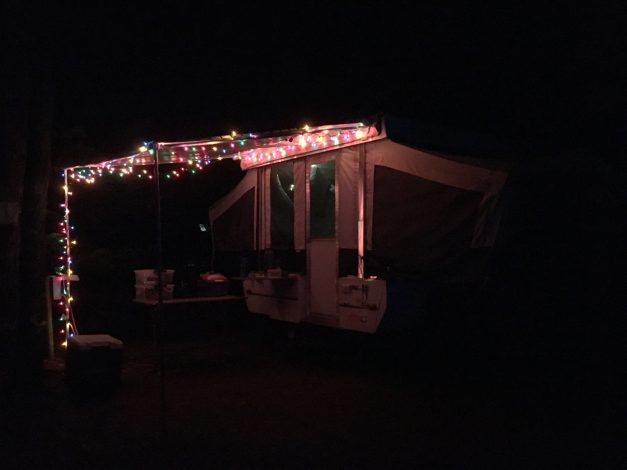
10 Fun Things To Do With Kids in Acadia
1. Park Loop Road
One of the first things that I would suggest doing is going on the Park Loop Road drive. This loop is a twisty 27-mile drive located on the eastern half of Mount Desert Island. It can be done all at once or over the course of your visit. You can also opt to do this loop as a guided bus tour or take the free Island Explorer shuttle. We didn’t use either option because the convenience of having our own car with two young children was really nice. Over the course of the drive, you'll pass many popular tourist destinations, mountains, rocky shorelines, dense forests and pristine lakes. The Park Loop Road is, hands down, one of the most beautiful drives in America. 
Photo from http://npmaps.com/acadia/.
2. Sand Beach
Our first stop was Sand Beach on the east side of Mount Desert Island. Because of the secluded nature of Newport Cove, this beach is able to exist. The cove protects it from the powerful waves and summer currents, allowing the sand to build. Sand Beach was a big hit with both our kids as they loved playing in the sand and running in and out of the water. Even though the water was too cold to swim in, the kids could have spent hours playing alongside it. There is also a really nice hiking trail, The Ocean Trail, that leaves from this parking area. The trail will take you right along the rocky shoreline from Sand Beach and Otter Cliffs. Insider tip: Even in the off-season, the parking for this location was packed, so plan on getting there early! 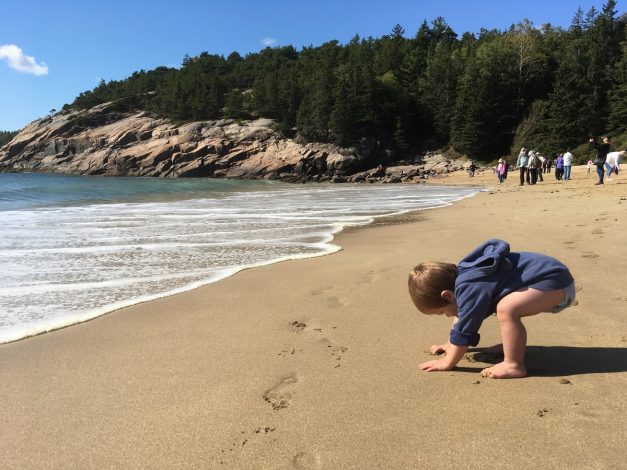
3. Thunder Hole
As we continued on along the Park Loop Road, our next stop was Thunder Hole. This was one of our favorite parts of the park. It is a narrow rock crevice that booms like thunder when waves hit it just right. At the end of the crevice, there is a small cave, and when waves rush in, they compress the air inside. If enough pressure builds, air explodes outward in a burst of spray. That is what makes the deep, thundering boom. It is best viewed/heard about two hours before high tide. We were very impressed with Thunder Hole and thought that it would be a wonderful place to cool off on a warm, summer day.
4. Jordan Pond House and Hike
Back in the car and super excited to check out our next stop, we made our way to Jordan Pond House. This restaurant has been serving guests for over a century and is famous for its tea and popovers. You MUST stop and get some of these delicious little air-filled, muffin-shaped popovers and spread jam/butter all over them. My husband and I had so much fun watching the kids run around on the huge lawn while sipping on tea, eating popovers and basking in the warm autumn sun. Insider tip: If you go when the weather is decent, I would recommend waiting the 1-2 hours for a table outside. There's also the option to make a reservation, but if you do, take into account the time it will take to find a parking spot, as this is a very popular destination. 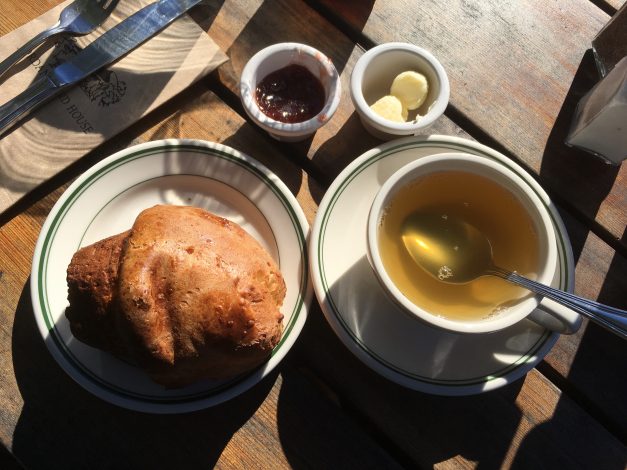 After tea and popovers, we headed to the pond to Jordan Pond as suggested from 100 Awesome Outdoor Adventures (p. 156). We enjoyed the clear blue waters of the pond, which is the deepest freshwater body of water on the island. The book mentions you can hike all the way around the pond (3.2 miles), but we only did a shorter route because of our young walkers. From the trail, you can see the two glacially sculpted mountains, North and South Bubble, that appear to be symmetrical. After your hike, as you continue your drive on Park Loop Road, keep your eyes out for Bubble Rock, located on South Bubble. This 14-ton boulder, precariously perched on a high ledge, was deposited by a melting glacier roughly 15,000 years ago. This is one of the most famous glacial erratics in the world!
After tea and popovers, we headed to the pond to Jordan Pond as suggested from 100 Awesome Outdoor Adventures (p. 156). We enjoyed the clear blue waters of the pond, which is the deepest freshwater body of water on the island. The book mentions you can hike all the way around the pond (3.2 miles), but we only did a shorter route because of our young walkers. From the trail, you can see the two glacially sculpted mountains, North and South Bubble, that appear to be symmetrical. After your hike, as you continue your drive on Park Loop Road, keep your eyes out for Bubble Rock, located on South Bubble. This 14-ton boulder, precariously perched on a high ledge, was deposited by a melting glacier roughly 15,000 years ago. This is one of the most famous glacial erratics in the world! 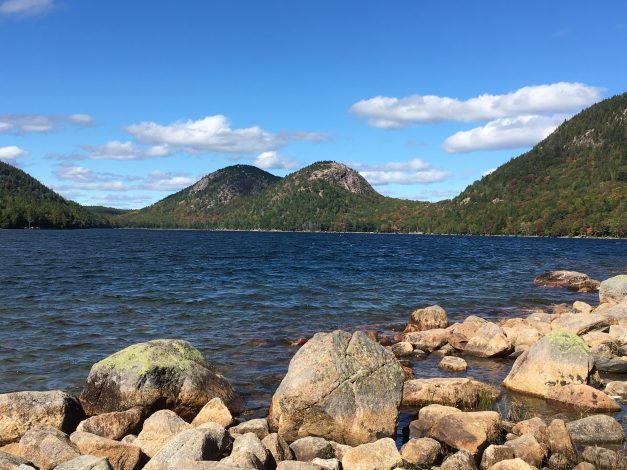
5. Cadillac Mountain
Famous for its 360-degree views, and being the highest point on the eastern seaboard, Cadillac Mountain is definitely worth a visit. Instead of hiking to the top of Cadillac Mountain on foot, we opted to drive the 3.5-mile road to the summit. We enjoyed the 0.3-mile Summit Trail at the top. This short loop offered a fantastic view of Mount Desert Island. While there, we were even able to see Bar Harbor and the cruise ships that were anchored off of the town. The view from the top was so beautiful that we even decided to head back the following day to eat dinner on the summit while watching the sun set. 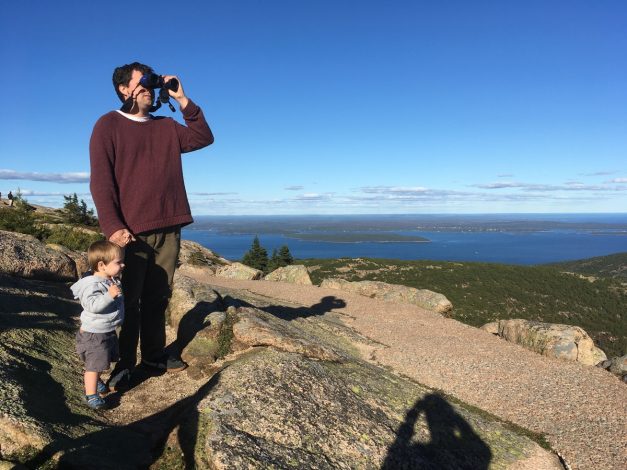
6. Wonderland Hike
Since we were in Acadia and there was another hike suggestion from 100 Awesome Outdoor Adventures (p. 154), of course we had to check it out! This hike is on Mount Desert Island but on the less-crowded western side. The Wonderland Trail is an easy 0.5-mile path that takes you through a pine forest and dumps you right on the Atlantic shore. This trail is known for its tide pools that are visible at low tide. Our kids really loved seeing all the little sea creatures that are only visible at this time of day. Insider tip: Check at the visitor center to find the times for low tide each day. There will be a publication available inside with a tide table. If you do choose to explore this trail, know that the tide pools are very slippery to walk on because of the seaweed. 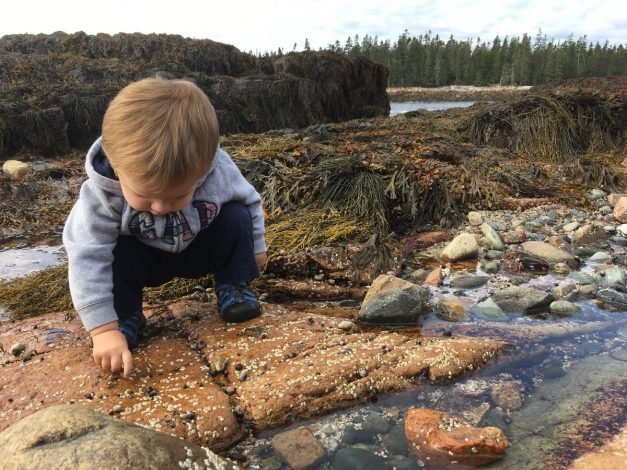
7. Bass Harbor Lighthouse
The next place we stopped was Bass Harbor Lighthouse. This lighthouse is the only one on Mount Desert Island and is located close to the Wonderland Hike. Built in 1858, Bass Harbor Lighthouse was originally lit by whale oil. It is now powered by electricity and fully automated, still guiding ships safely into the harbor. We enjoyed seeing this pretty lighthouse. Please note that you aren’t allowed to go in it, so if you're short on time, you can skip this location. 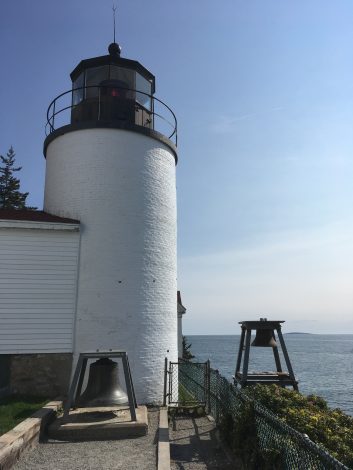
8. Bar Harbor
After a long day of hiking, we stopped in the quintessential Maine Coastal Town of Bar Harbor right before sunset. It made for a gorgeous walk along the harbor and a nice seafood dinner right on the water. While walking the 0.75-mile Bar Harbor Shore Path, we stopped at Balance Rock since it was suggested by a few of the travel guides. This boulder was left on the shore of Bar Harbor by glaciers during the last Ice Age. It was an impressive site to see and made for some funny pictures! If you make it to the end of the Shore Path, take note of the Bar Harbor breakwater. This man-made stone wall that shelters Bar Harbor from large offshore waves is rumored to have been built by J.P. Morgan so large waves wouldn’t spill cocktails on his yacht. After dinner, we walked around the cute town, stopping in the little stores and eating ice cream. It was the perfect way to end the night. 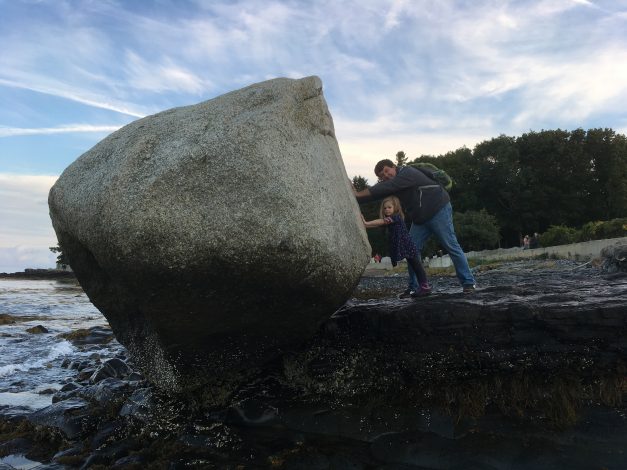
9. Little Hunter’s Beach
One of the final stops for us at Acadia was Little Hunter’s Beach. This beach was extremely different from Sand Beach. Instead of soft, brown sand, the beach is covered in cobblestones that were formed roughly 370 million years ago and shaped like Easter eggs. At the time, we were disappointed that it was raining. However, while walking back to our car, we noticed that the dry rocks under the trees were not nearly as pretty as the wet ones. All four of us thoroughly enjoyed the different colors and sizes of the cobblestones. It was hard to resist scooping up a bucketful and taking some home with us. (Don’t do that, it’s illegal!) Insider tip: To get to Little Hunter’s Beach, drive roughly two miles past Otter Point. Look for a small wooden staircase on the left side of the road. The staircase is tricky to find, but once you do, it will lead you down to the beach. 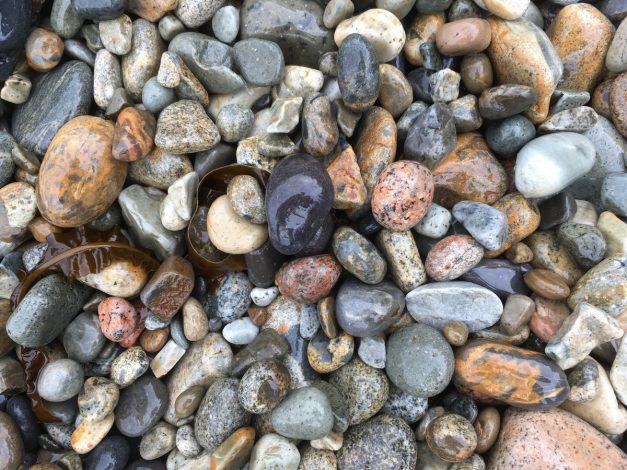
10. Carriage Roads
Throughout Acadia, there are over 57 miles of gravel carriage roads which were built by John D. Rockefeller starting in 1910. They are closed to motorized traffic, but hiking and horseback riding are allowed on them. These carriage roads twist and turn through Acadia, revealing the island’s lush interior, which includes 17 beautiful stone bridges, handcrafted by stone masons out of rock native to the area. Even if you don’t have time to hike on any of the carriage roads, keep your eyes out for the impressive bridges. They are definitely worth stopping to photograph. 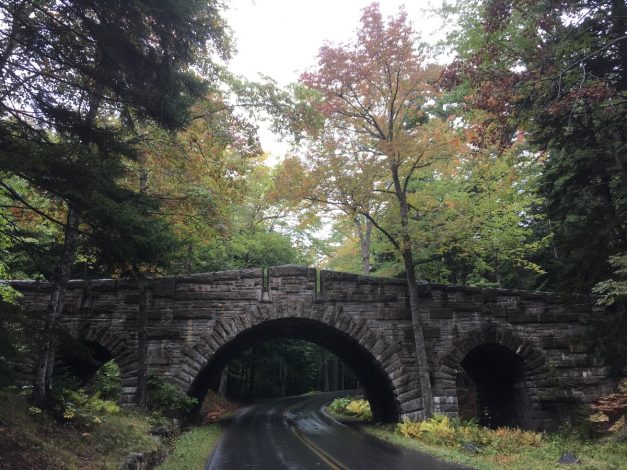 The whole family was sad to say goodbye to Acadia. We would have loved to spend a whole week or two exploring the rest of the park and some of the other islands. Acadia definitely goes down in my book as one of the most beautiful national parks that I’ve visited in the United States. We hope to return one day to hike along its cliffs and play in its water once more. What are your favorite spots to visit in Acadia National Park? Please share with us in the comments below.
The whole family was sad to say goodbye to Acadia. We would have loved to spend a whole week or two exploring the rest of the park and some of the other islands. Acadia definitely goes down in my book as one of the most beautiful national parks that I’ve visited in the United States. We hope to return one day to hike along its cliffs and play in its water once more. What are your favorite spots to visit in Acadia National Park? Please share with us in the comments below.
HELPFUL RESOURCES
- Acadia: The Complete Guide (James Kaiser)
- Hike it Baby: 100 Awesome Outdoor Adventures with Babies and Toddlers (Shanti Hodges)
- Hike it Baby Family Trail Guide
- National Park Services
Read more:
- 10 Fun things to do with kids in Yellowstone
- 6 Helpful websites to make outdoor adventure planning easy
- Ways to pack snacks and food on road trips
Photos by Natalie Kendrach.
ABOUT OUTGROWN
OutGrown is a 501(c)(3) nonprofit that works to create a world where everyone can enjoy the physical and mental benefits of spending time outside. We are focused on creating opportunities and removing barriers to access so families with babies and young children can take their first steps outside. We believe all families have the right to connect with nature, benefit from spending time outdoors and be inspired to a lifelong love of nature. Since its grassroots inception in 2013, OutGrown is a growing community of 280,000 families and over 300 volunteer Branch Ambassadors. More information on all of our programs can be found at WeAreOutGrown.org
EDITORS NOTE:
We hope you enjoyed reading this article from OutGrown. We’re working hard to provide our community with content and resources that inform, inspire, and entertain you.
But content is not free. It’s built on the hard work and dedication of writers, editors, and volunteers. We make an investment in developing premium content to make it easier for families with young children to connect with nature and each other. We do not ask this lightly, but if you can, please make a contribution and help us extend our reach.
Related Content


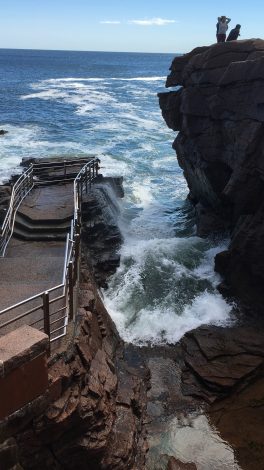
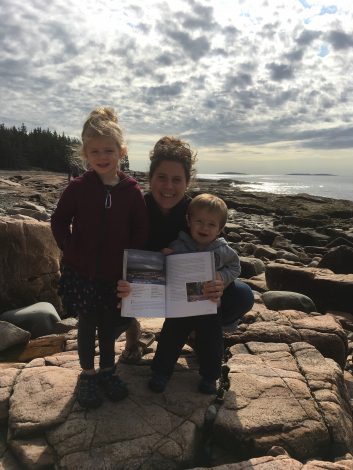
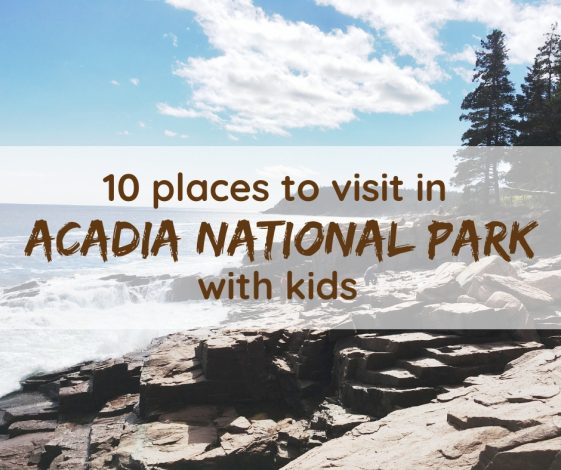


Comments